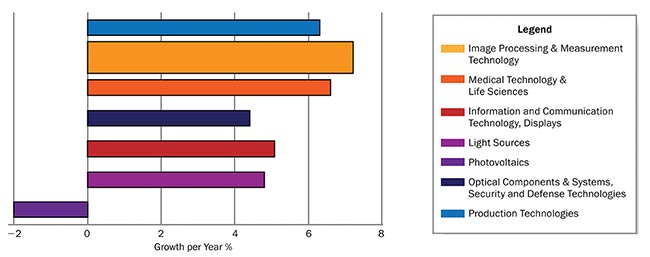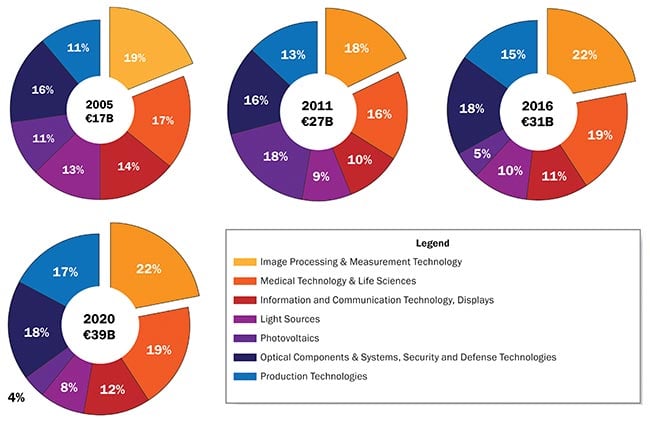
Europe Emerges as Major Player in Imaging
Imaging technology and systems are moving into a top spot in the photonics market. This trend is the result of rising demand for advanced health and wellness treatments and noninvasive medical procedures, as well as megatrends in industrial automation, defense and personal safety. And Europe is a top player.
“The European industry holds substantial market shares in … measurement and image processing” touting a 35 percent of the world market share, according to a 2017 market research study by European technology platform Photonics21, in conjunction with market analyst group Optech Consulting. That 35 percent represents some of the largest shares in the global market. The study also found that imaging/image processing and measurement technology is among the largest segments in European photonics production, with a volume of €11.7 billion ($13.8 billion).

Development and forecast of photonics in Germany, 2005 to 2020. Courtesy of Optech Consulting 2017.
“Imaging systems also play an important role for the German photonics market,” said Ursula Tober, senior economist and technology consultant for Photonics21. She is also senior economist and technology consultant for Innovations Management and Consultancy Photonics at VDI Technologiezentrum. In fact, the Photonics21 study states that Germany is “the largest producer of photonics in Europe, with a share of 41.3 percent.” (See sidebar.)
Tober said Germany’s image processing and measurement technology production holds about 19 percent of total world market shares, citing the 2017 Photonics in Germany Industry Report by VDMA (The Mechanical Engineering Industry Association) and Optech Consulting. This represents a significant increase since 2011 that has been facilitated, in part, she said, by “increasing local demand and export successes.” This segment has seen average growth of 5.6 percent annually, and it is “expected to increase up to a production volume of €8.5 billion ($10 billion) by 2020, thereby remaining the strongest photonics sector in Germany.” In all, market analysts anticipate the image processing systems sector could increase further by as much as 20 percent by 2020.

Compound annual growth of domestic production in Germany from 2011 to 2016. Courtesy of Optech Consulting 2017.
Germany’s medical technology and life sciences market segment is becoming particularly strong, Tober said, because of an increasing demand for imaging systems for applications such as non- or minimally invasive surgical procedures and fast on-site diagnosis and analysis. The VDMA report expects this sector to grow an average of 6.3 percent annually over the next several years to reach a production volume of €7.5 billion ($9 billion).
Imaging systems are becoming a key technology in industrial automation in Europe, as well. “Thanks to imaging, machines can ‘see and understand,’” according to German industry association Spectaris. This, in turn, has a positive impact on product quality, productivity, and the stability and efficiency of production processes. “Imaging paves the way for increasingly more flexible and smart production in Industry 4.0.”
Major Growth Predicted for Imaging Market
Ursula Tober — senior economist and technology consultant for Photonics21, and senior economist and technology consultant for Innovations Management and Consultancy Photonics at VDI Technologiezentrum — offered Photonics Spectra her expert insight into the state of the global imaging market, and what it means for the future of the industry.
What are the current trends in the imaging market?
Photonic imaging systems within our studies play a major role in the area of medical technology, and are also represented in the area of defense and security. High-performance optics [are] used in applications such as astronomy and inertial fusion experiments. [These are] all segments driven by global megatrends of an increased need for health and wellness, [an] aging population in mature industrial regions, increased need and demand for personal safety and security, as well as homeland security.
Imaging systems also drive positively, to some extent, the photonics growth in the component segment.
Where are you seeing the most market development?
There will be global demand and needs. We believe that Europe had and will have a good performance in [imaging] due to strong players like Leica [Microsystems] and Zeiss. Europe also has a strong position in the area of medical technology. The solid growth [from] 2011 to 2015 (at a CAGR of 7.2 percent) in the EU Photonics medical technology segment is, amongst others, majorly attributable to photonics imaging systems.
Production in Europe accounts for €9.6 billion ($11.3 billion) — corresponding to 28 percent of the global market — ahead of North America, with a 27 percent share, and Japan, with a 22 percent share.
What do you anticipate for the future of the global imaging market?
We expect the high-performance imaging systems to remain a growth driver long term.
Future demand will also increasingly come from the area of logistics and transport, and further performance enhancement, as well as system integration for faster, reliable data analytics and interpretation.
Published: September 2017